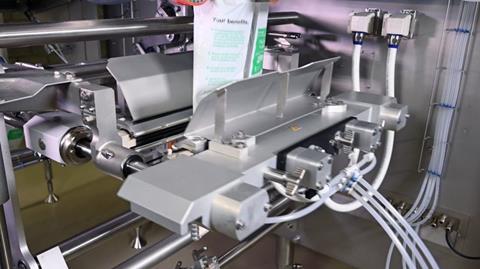
In the latest of our finalist interviews for our Sustainability Awards 2021, we learn about Syntegon Packaging Solutions B.V. and SABIC’s BOPE solution for frozen food - a packaging concept for the frozen food industry with what is described as a substantial material reduction potential.
Congratulations on being selected by the international judging panel as a Sustainability Awards 2021 finalist! Could you please introduce your successful entry and what’s innovative about it?
Syntegon and SABIC developed a solution for the frozen food industry which is based on the PHS 2.0 sealing technology from Syntegon and a 20 micrometer mono web TF-BOPE film structure(TF-BOPE stands for Biaxial oriented Polyethelyne on a Tenter Frame machine) made from SABIC’s polyethylene (PE) material.
Syntegon’s PHS 2.0 sealing system includes servo-driven sealing jaws, an active knife and two-sided heated sealing strips for more consistent, high-quality seals. The new sealing technology stands out for its material efficiency and speed: it reduces the required clamped film surface by up to 6.8 percent and increases the packaging speed by as much as 25 percent – up to 130 bags per minute. The increase in speed is achieved by reducing the sealing and cooling times by 50 and 30 percent, respectively.
This is made possible due to the thin TF-BOPE film made of SABIC® LLDPE BX202 material. This film offers a high dart-impact and puncture resistance combined with low tear strength and uniform tear direction an easy unidirectional opening is provided. Compared to blown PE film, it offers better visibility of packaged products due to higher light transmission and lower haze. Meanwhile the high gloss delivers first-class design and aesthetics.
The PHS 2.0 sealing technology can process thinner films whilst offering the same level of sealing quality, product protection and processing speed as conventional sealing technologies. When replacing composite packaging materials on new and existing Syntegon VFFS machines with films made of SABIC’s BOPE, brand owners benefit from material and cost savings.

Q2: What are the environmental challenges in packaging that your entry addresses, and what impact do you hope it will make?
Reducing the material’s environmental impact and increasing recyclability are two key themes that we address. The TF-BOPE film based on SABIC LLDPE BX202 grade has a thickness of only 20 micrometers. This thin gauge provides a potential packaging material reduction of approximately 35-50% compared to incumbent blown PE film. The reduced thickness of the packaging together with the smaller clamp section the solution minimizes environmental impact and supports brand owners and retailers who are aiming to reduce their packaging material consumption and related tax penalties. The new packaging solution is also 100% recyclable and fits to existing mono-PE recycling streams.
TF-BOPE has the potential to be used in new applications and markets, which support the circular economy, where mono material solutions are required to enhance recyclability. TF-BOPE can replace multi material laminates into a mono-PE structure. SABIC’s PE material for TF -BOPE film is part of the “Design for Recyclability” under TRUCIRCLE™ solutions and supports easy and full recyclability through enabling mono-PE material structures in multilayer flexible packaging, aiming to minimize waste.
Q3: I’d like to ask you about the broader picture beyond your successful entry. ‘Sustainability’ in packaging is multi-dimensional – both in terms of objectives and challenges. Could you comment on the most important roadblocks you identify from your position in the value chain, and the kinds of solutions you would like to see addressing them (e.g. areas of technological innovation, collaboration, regulation)?
Sustainability a is priority in the value chain of the packaging industry today. Both SABIC and Syntegon as suppliers to the packaging value chain demonstrate the value of collaboration with this submitted innovative packaging solution. To tackle tomorrow’s challenges, stakeholders across the supply chain need to work together to bring new solutions to life as sustainability cannot be achieved single-handedly.
We also believe that in order to support the industry in becoming more sustainable, future packaging solution development should more often incorporate an analysis of the life cycle impacts of the new design compared with alternatives. Such an analysis might assess the packed product to packaging weight ratio, the recyclability rating, the carbon and water consumption footprints, etc. These factors should be considered alongside ensuring the quality of the packaged product is maintained and food spillage is prevented and should be reflected in clearly aligned regulation worldwide (not the case today).
This BOPE film can also be available as a certified circular polymer from SABIC’s TRUCIRCLE™ portfolio. Advanced (or chemical) recycling takes mixed used plastic that is challenging to recycle via traditional routes and converts it into new feedstock to manufacture virgin polymers. It’s crucial that we move from a linear to a circular economy, and advanced recycling can enable our industry to do this as well as sophisticated recycling streams across the globe.
Our aim for the future is that plastics should never end up in the environment or in landfill and instead are reused and remade into new products. We are on a journey towards creating a circular economy for plastics – but there is more that needs to be done across the value chain before we can achieve this. We need to accelerate the conversation about the changes we need to make to become a circular global society for the good of people and the planet. We have to make steps to transform our businesses and processes whilst we define our circular economy – and we need to continue to collaborate, innovate and engineer new technologies to drive the circular model, whilst regulations and frameworks start to take shape. We need to take these first steps together today to drive the change, so we can start to use our finite resources wisely.











